Abstract
Lysozyme turnover studies with 125I-labeled human lysozyme were carried out on 22 patients, viz. nine control patients, seven nephrological patients with varying degrees of renal insufficiency, including three bilaterally nephrectomized patients, and six hematological patients with disturbed turnover of the neutrophilic granulocytes.
It was found that plasma lysozyme has a rapid turnover with a fractional catabolic rate of 76%/hr of the plasma content. Lysozyme catabolism varied with the endogenous creatinine clearance; in addition however, extrarenal sites of catabolism were demonstrated since lysozyme could be broken down in the anephric patients, although only at a rate amounting to about 15% of the rate found in persons with intact kidneys. In the uremic patients the increased plasma lysozyme concentration was due to decreased rates of catabolism; in the hematological patients the increased plasma lysozyme level was due to increased rates of synthesis which supports the hypothesis that plasma lysozyme mainly stems from disintegrating neutrophilic granulocytes. Furthermore, it was shown that in the nonhematological patients examined, the rate of synthesis varied with the endogenous creatinine clearance.
Full text
PDF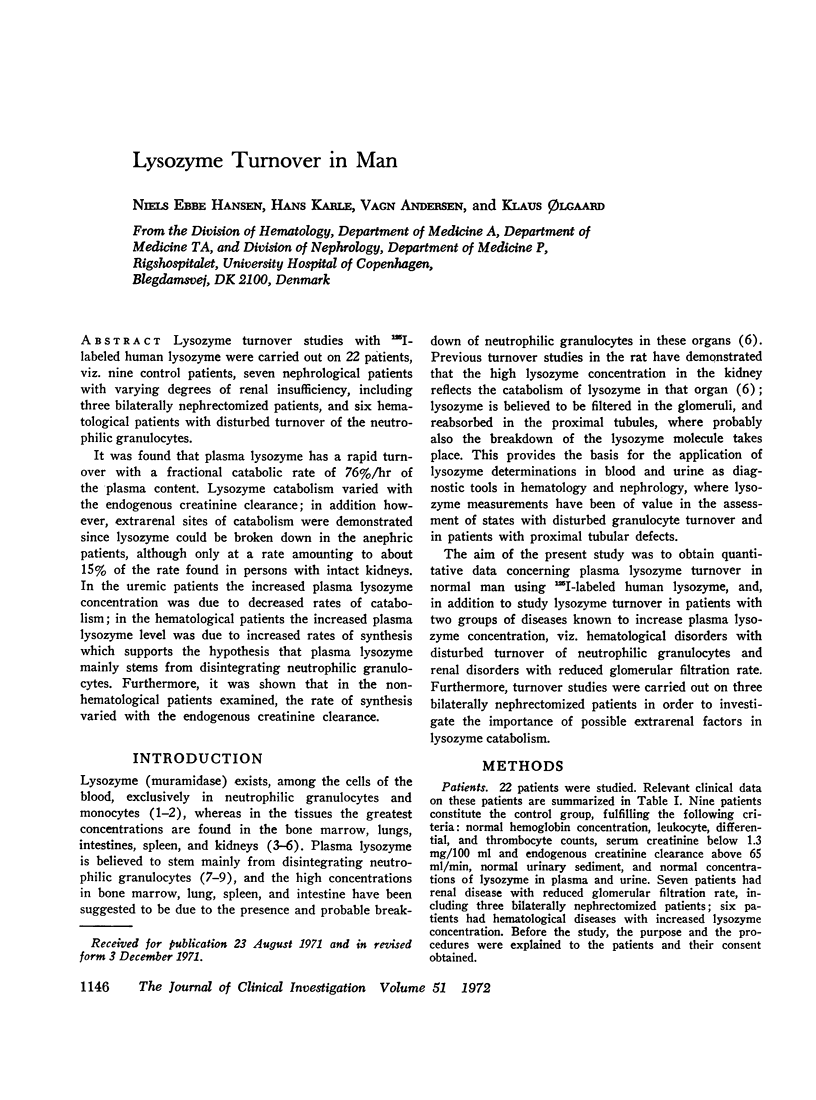

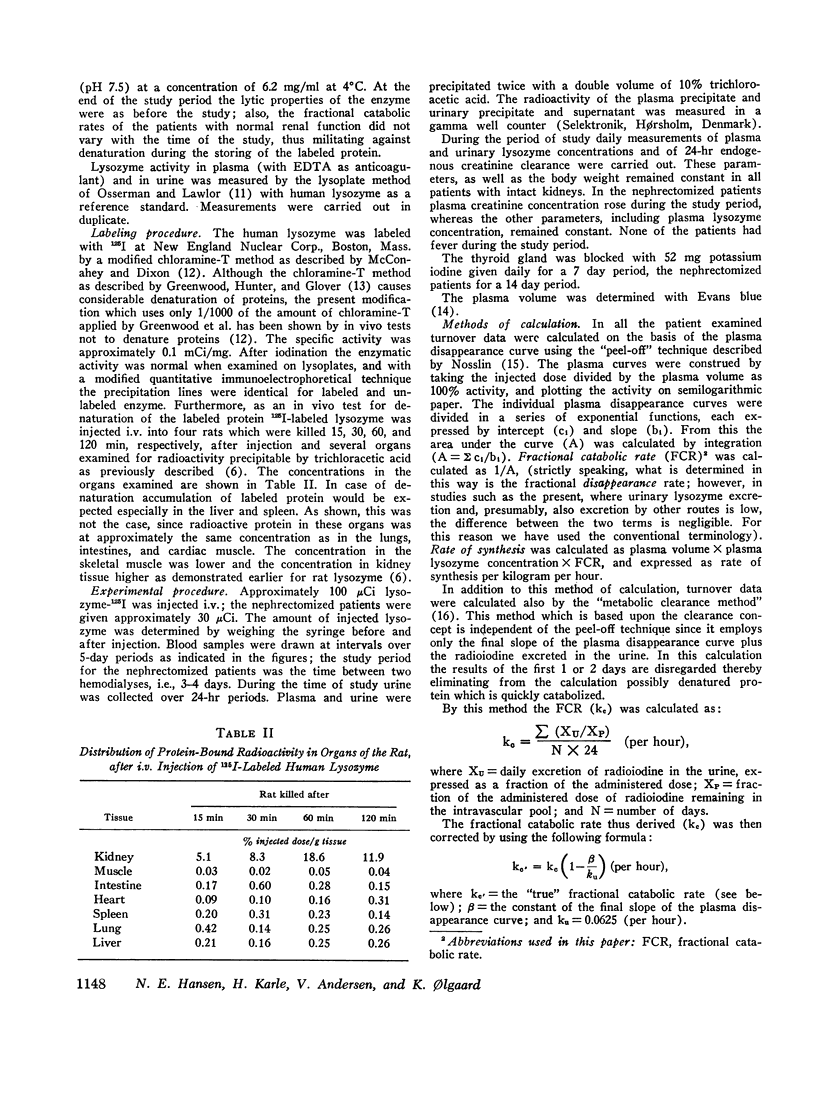
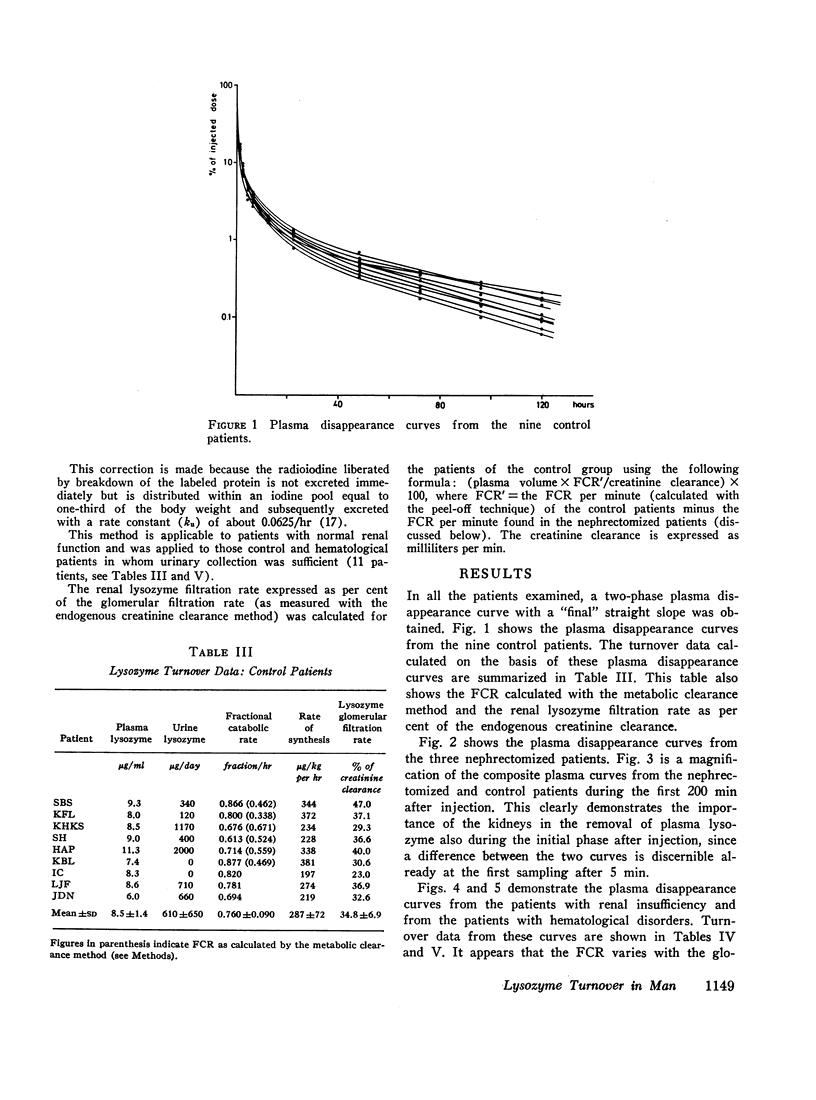


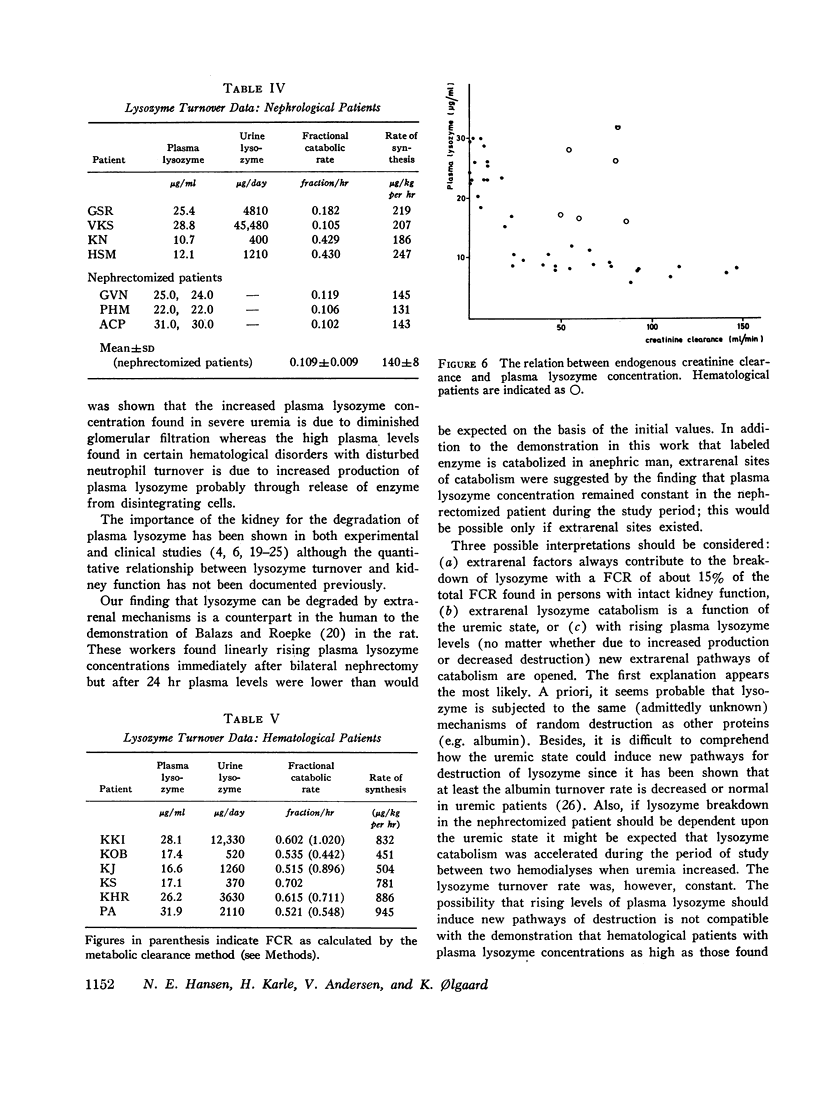
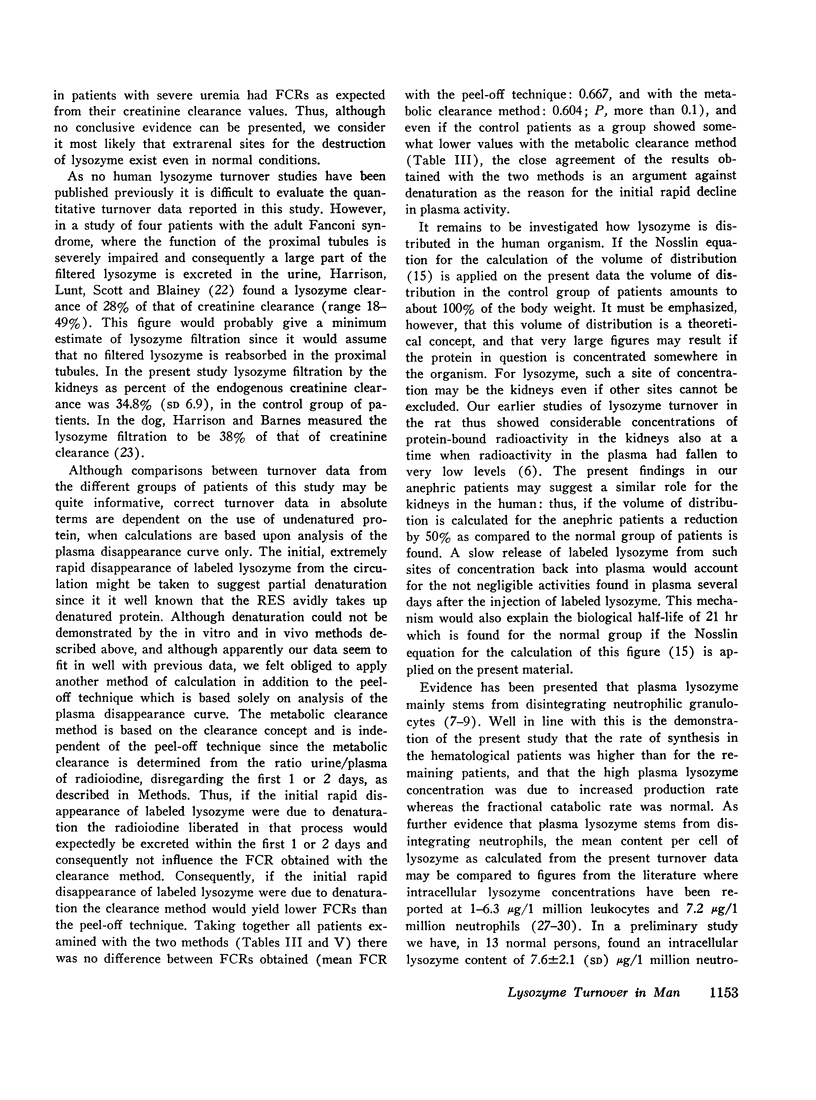
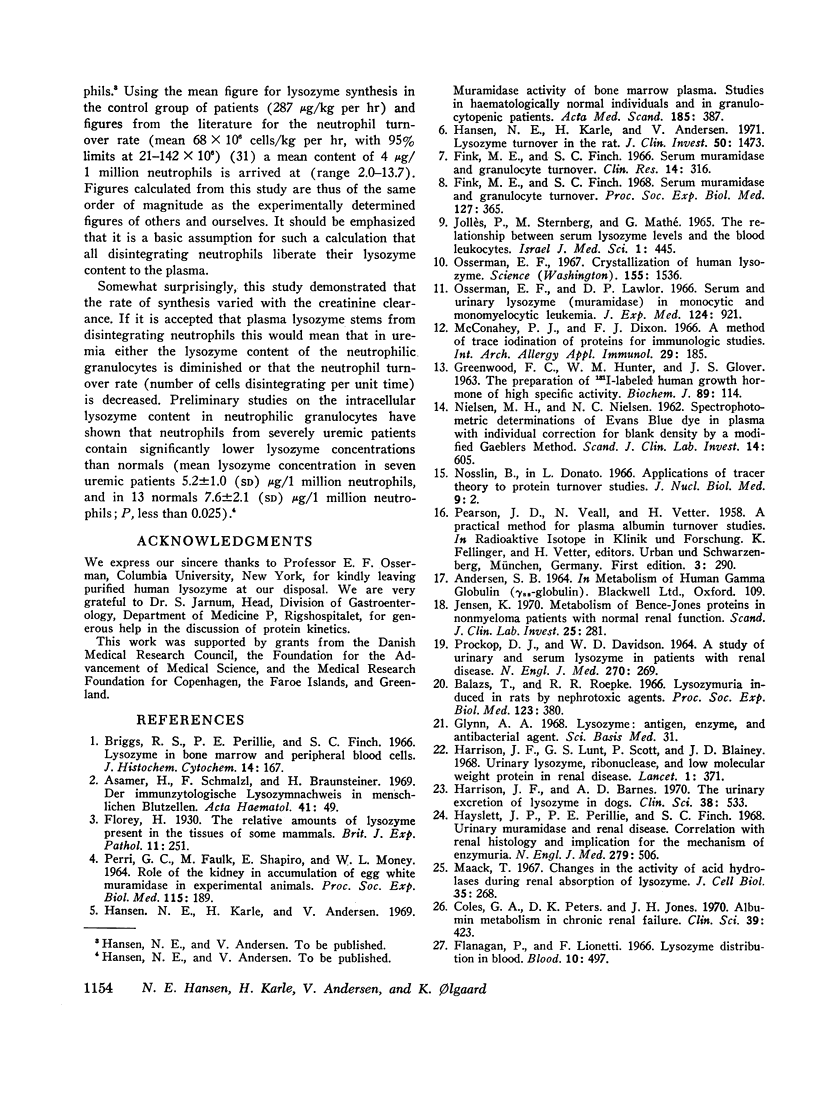

Selected References
These references are in PubMed. This may not be the complete list of references from this article.
- Asamer H., Schmalzl F., Braunsteiner H. Der immunzytologische Lysozymnachweis in menschlichen Blutzellen. Acta Haematol. 1969;41(1):49–54. doi: 10.1159/000208830. [DOI] [PubMed] [Google Scholar]
- Balazs T., Roepke R. R. Lysozymuria induced in rats by nephrotoxic agents. Proc Soc Exp Biol Med. 1966 Nov;123(2):380–385. doi: 10.3181/00379727-123-31494. [DOI] [PubMed] [Google Scholar]
- Briggs R. S., Perillie P. E., Finch S. C. Lysozyme in bone marrow and peripheral blood cells. J Histochem Cytochem. 1966 Feb;14(2):167–170. doi: 10.1177/14.2.167. [DOI] [PubMed] [Google Scholar]
- CARTWRIGHT G. E., ATHENS J. W., WINTROBE M. M. THE KINETICS OF GRANULOPOIESIS IN NORMAL MAN. Blood. 1964 Dec;24:780–803. [PubMed] [Google Scholar]
- Coles G. A., Peters D. K., Jones J. H. Albumin metabolism in chronic renal failure. Clin Sci. 1970 Sep;39(3):423–435. doi: 10.1042/cs0390423. [DOI] [PubMed] [Google Scholar]
- FLANAGAN P., LIONETTI F. Lysozyme distribution in blood. Blood. 1955 May;10(5):497–501. [PubMed] [Google Scholar]
- Fink M. E., Finch S. C. Serum muramidase and granulocyte turnover. Proc Soc Exp Biol Med. 1968 Feb;127(2):365–367. doi: 10.3181/00379727-127-32692. [DOI] [PubMed] [Google Scholar]
- GREENWOOD F. C., HUNTER W. M., GLOVER J. S. THE PREPARATION OF I-131-LABELLED HUMAN GROWTH HORMONE OF HIGH SPECIFIC RADIOACTIVITY. Biochem J. 1963 Oct;89:114–123. doi: 10.1042/bj0890114. [DOI] [PMC free article] [PubMed] [Google Scholar]
- Hansen N. E., Karle H., Andersen V. Lysozyme turnover in the rat. J Clin Invest. 1971 Jul;50(7):1473–1477. doi: 10.1172/JCI106632. [DOI] [PMC free article] [PubMed] [Google Scholar]
- Hansen N. E., Karle H., Andersen V. Muramidase activity of bone marrow plasma. Studies in haematologically normal individuals and in granulocytopenic patients. Acta Med Scand. 1969 May;185(5):387–392. [PubMed] [Google Scholar]
- Harrison J. F., Barnes A. D. The urinary excretion of lysozyme in dogs. Clin Sci. 1970 Apr;38(4):533–547. doi: 10.1042/cs0380533. [DOI] [PubMed] [Google Scholar]
- Harrison J. F., Lunt G. S., Scott P., Blainey J. D. Urinary lysozyme, ribonuclease, and low-molecular-weight protein in renal disease. Lancet. 1968 Feb 24;1(7539):371–375. doi: 10.1016/s0140-6736(68)91350-0. [DOI] [PubMed] [Google Scholar]
- Hayslett J. P., Perillie P. E., Finch S. C. Urinary muramidase and renal disease. Correlation with renal histology and implication for the mechanism of enzymuria. N Engl J Med. 1968 Sep 5;279(10):506–512. doi: 10.1056/NEJM196809052791002. [DOI] [PubMed] [Google Scholar]
- Jensen K. Metabolism of bence jones proteins in non-myeloma patients with normal renal function. Scand J Clin Lab Invest. 1970 May;25(3):281–289. doi: 10.3109/00365517009046207. [DOI] [PubMed] [Google Scholar]
- Maack T. Changes in the activity of acid hydrolases during renal reabsorption of lysozyme. J Cell Biol. 1967 Oct;35(1):268–273. doi: 10.1083/jcb.35.1.268. [DOI] [PMC free article] [PubMed] [Google Scholar]
- McConahey P. J., Dixon F. J. A method of trace iodination of proteins for immunologic studies. Int Arch Allergy Appl Immunol. 1966;29(2):185–189. doi: 10.1159/000229699. [DOI] [PubMed] [Google Scholar]
- NIELSEN M. H., NIELSEN N. C. Spectrophotometric determination of Evans blue dye in plasma with individual correction for blank density by a modified Gaeblers method. Scand J Clin Lab Invest. 1962;14:605–617. [PubMed] [Google Scholar]
- Noble R. E., Fudenberg H. H. Leukocyte lysozyme activity in myelocytic leukemia. Blood. 1967 Oct;30(4):465–473. [PubMed] [Google Scholar]
- Osserman E. F. Crystallization of human lysozyme. Science. 1967 Mar 24;155(3769):1536–1537. doi: 10.1126/science.155.3769.1536. [DOI] [PubMed] [Google Scholar]
- Osserman E. F., Lawlor D. P. Serum and urinary lysozyme (muramidase) in monocytic and monomyelocytic leukemia. J Exp Med. 1966 Nov 1;124(5):921–952. doi: 10.1084/jem.124.5.921. [DOI] [PMC free article] [PubMed] [Google Scholar]
- PERRI G. C., FAULK M., SHAPIRO E., MONEY W. L. ROLE OF THE KIDNEY IN ACCUMULATION OF EGG WHITE MURAMIDASE IN EXPERIMENTAL ANIMALS. Proc Soc Exp Biol Med. 1964 Jan;115:189–192. doi: 10.3181/00379727-115-28866. [DOI] [PubMed] [Google Scholar]
- PROCKOP D. J., DAVIDSON W. D. A STUDY OF URINARY AND SERUM LYSOZYME IN PATIENTS WITH RENAL DISEASE. N Engl J Med. 1964 Feb 6;270:269–274. doi: 10.1056/NEJM196402062700602. [DOI] [PubMed] [Google Scholar]


